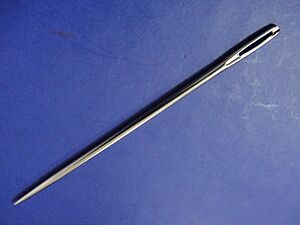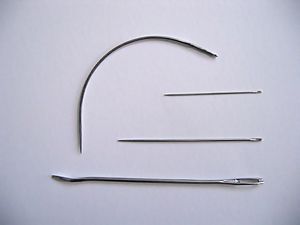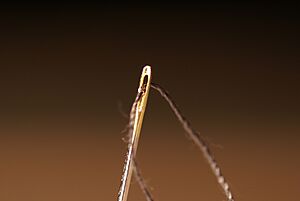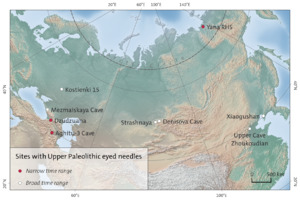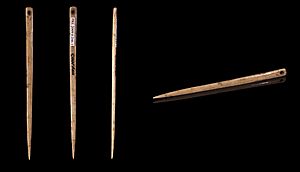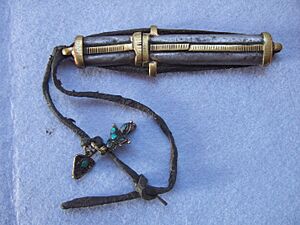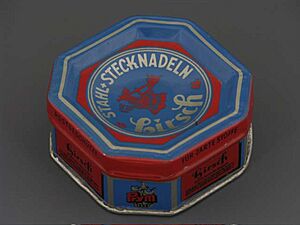Sewing needle facts for kids
A sewing needle is a long, thin tool with a sharp point at one end. It has a small hole, called an eye, at the other end to hold a thread. People use needles for hand-sewing, which means stitching fabrics together by hand.
The very first needles were made from things like bone or wood. Today, most needles are made from strong carbon steel wire. They are often coated with nickel or even gold to stop them from rusting. Special needles for embroidery (decorative stitching) might even be coated with platinum and titanium alloy to make them extra strong.
People often keep their sewing needles safe in special containers. These can be "needle books" or "needlecases," which are sometimes very pretty. Another type of container is an étui, which is a small box that can hold needles, tiny scissors, pencils, and other small tools.
Contents
Different Types of Hand Sewing Needles
There are many different kinds of hand-sewing needles. Each type is made for a specific job, and they also come in various sizes.
- Sharp Needles: These are good for everyday sewing. They have a sharp point, a round eye, and are a medium length. Some have two eyes, which lets you use two threads at once without making too much friction on the fabric.
- Appliqué Needles: These are also general-purpose needles, great for sewing, appliqué (attaching fabric pieces), and patchwork.
- Embroidery Needles: Also called crewel needles, they are like sharp needles but have a longer eye. This makes it easier to thread multiple embroidery threads or thicker yarns.
- Betweens or Quilting Needles: These needles are shorter than sharp needles and have a small, round eye. They are used for making tiny stitches on thick fabrics, like when you are making a quilt or doing detailed tailoring.
- Milliners Needles: These needles are generally longer than sharp needles. They are useful for basting (temporary stitches) and pleating, especially in hat-making.
- Easy- or Self-threading Needles: These needles have a special open slot instead of a closed eye. This makes it very easy to guide the thread into the needle. They are also called calyx-eyed, side threading, or spiral eye needles.
- Beading Needles: These are very thin needles with a narrow eye. This design allows them to fit through the tiny holes in beads and sequins. They also have a long shaft to hold many beads at once.
- Bodkin Needles: Also known as ballpoints, these are long, thick needles with a rounded tip and a large, long eye. They can be flat or round. People use them to pull elastic, ribbon, or tape through fabric channels or lace openings.
- Chenille Needles: These are similar to tapestry needles but have large, long eyes and a very sharp point. They are good for pushing through tightly woven fabrics, especially for ribbon embroidery.
- Darning Needles: Sometimes called finishing needles, these have a blunt tip and a large eye, similar to tapestry needles, but they are longer. Thicker versions are used for darning yarn.
- Doll Needles: These are not for regular sewing. They are long and thin and used for shaping soft dolls, especially for making facial details.
- Leather Needles: Also known as glovers or wedge needles, these have a triangular point. This special point helps them pierce leather without tearing it. They are also used for materials like vinyl and plastic.
- Sailmaker Needles: Similar to leather needles, but their triangular point goes further up the shaft. They are designed for sewing thick canvas or heavy leather.
- Tapestry Needles: These needles have a large eye for thicker yarn and a blunt tip. The blunt tip, which is sometimes slightly bent, helps them pass through loosely woven fabrics like embroidery canvas without snagging. Some even have a double eye for using two colors of thread.
- Tatting Needles: These are long and have the same thickness all the way along, including at the eye. This design helps pull the thread smoothly through the double stitches used in tatting.
- Upholstery Needles: These are heavy, long needles that can be straight or curved. They are used for sewing heavy fabrics, upholstery work, and tying quilts. Curved needles are helpful for hard-to-reach spots on furniture. Very long ones (30 cm) are used for repairing mattresses.
Parts of the Sewing Needle
A sewing needle has six main parts:
- The shaft is the main, long part of the needle.
- The shank is the part you hold when hand-sewing, or the part that connects to a sewing machine.
- The groove is a small dent that runs along the shaft. It helps the thread lie flat against the needle as it goes through the fabric.
- The eye is the small hole near the tip of the needle where you put the thread.
- The scarf is a special part that helps the sewing machine hook form a stitch.
- The point is the very tip of the needle that pushes through the fabric.
Needle Size
Needle sizes are shown by numbers on the package. Usually, for any type of needle, a smaller number means a thicker and longer needle. For example, a size 9 needle will be thicker and longer than a size 12 needle.
However, needle sizes are not always the same across different types of needles. A size 10 needle of one type might be thinner or finer than a size 12 needle of another type.
If a package says something like "20 Sharps 5/10," it means there are 20 sharp needles in total, with a mix of sizes 5 and 10 (usually ten of each). Another example, "16 Milliners 3/9," means 16 milliners needles in sizes from 3 to 9.
History of Sewing Needles
Early Sewing Needles
The very first sewing probably involved tying animal skins together. People might have used sharp pieces of bone as needles and animal tendons or plant fibers as thread. The biggest challenge was making a small enough hole in the bone without damaging the material.
Scientists have found very old needles:
- A possible bone needle tip from 61,000 years ago was found in Sibudu Cave, South Africa.
- A bone needle, about 50,000 years old, was found in Denisova Cave. It is believed to have been made by early humans called Denisovans.
- Another bone needle, from 47,000 to 41,000 years ago, was found in Potok Cave in Slovenia.
- Bone and ivory needles from 30,000 to 23,000 years ago were found in China.
- Ivory needles from 30,000 years ago were also found in Russia.
- Neolithic bone needles, 8,600 years old, were discovered in Turkey.
- Flinders Petrie found copper sewing needles in Naqada, Egypt, dating from 4400 BC to 3000 BC.
- Iron sewing needles from the third century BC were found in Germany.
Ancient Sewing Needles
A type of needle lace called nålebinding was used thousands of years ago, even before knitting and crochet. It was good because it could use shorter, rougher threads.
Native Americans used needles from nature. For example, the agave plant provided both the needle and the "thread." After soaking an agave leaf, the sharp tip and long fibers could be used for sewing.
Making sewing needles became possible with the invention of wire-making technology around 2000 BC. Early copper and bronze needles were made by bending the wire back on itself to create the eye.
Later Sewing Needles
A big step forward in needle-making happened in the tenth century when high-quality steel-making technology came from China to Spain. This allowed for the production of good quality steel in large amounts. This technology then spread to Germany and France.
In England, needle-making began in 1639 in a town called Redditch. They developed a method called "drawn-wire," which is still used today. Around 1655, needle makers in London formed a special group called the Guild of Needlemakers. Redditch remained the main place for making needles. In Japan, there is a special festival called Hari-Kuyo, the Festival of Broken Needles, which started in the 1600s.
See also
 In Spanish: Aguja para niños
In Spanish: Aguja para niños
- Needle threader
- Needlecase
- Sewing machine needle
- Thimble
- Treen
- Hari-Kuyō


